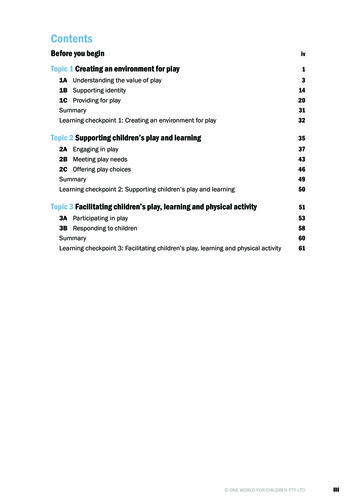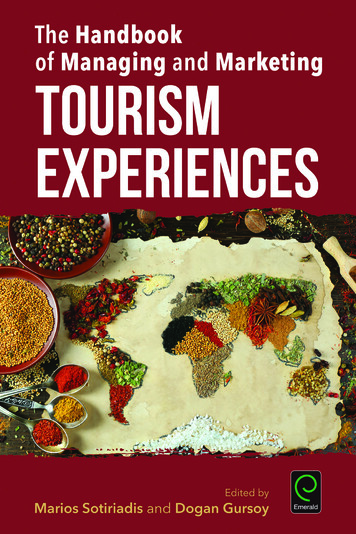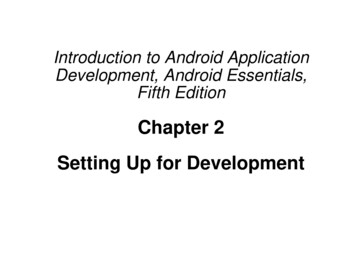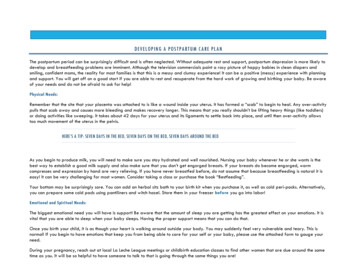
Transcription
ContentsBefore you begin ivTopic 1 Creating an environment for play 11A Understanding the value of play 31B Supporting identity 141C Providing for play 20Summary 31Learning checkpoint 1: Creating an environment for play 32Topic 2 Supporting children’s play and learning 352A Engaging in play 372B Meeting play needs 432C Offering play choices 46Summary 49Learning checkpoint 2: Supporting children’s play and learning 50Topic 3 Facilitating children’s play, learning and physical activity 513A Participating in play 533B Responding to children 58Summary 60Learning checkpoint 3: Facilitating children’s play, learning and physical activity 61iii
Topic 1In this topic you will learnabout:1A Understanding the valueof play1B Supporting identity1C Providing for playCreating an environmentfor playChildren learn about themselves and the worldaround them through play. Providing a stimulating,challenging and safe environment allows childrento explore, discover and grow in their abilities. Anenvironment that allows children to make choices,and reflects their diversity, interests and abilities willenhance their play and leisure time.1
Topic 1 Creating an environment for playAs well as consolidating skills children have mastered, play enables them to use theirbodies in many new and challenging ways; for example, climbing, standing, stretching,grasping and hopping.Physical activities assist children to:develop strength and staminaXX release excess energyXX learn hand–eye and feet–eye coordinationXX develop balance.Watch this video about children’s physical development.v 0062XXSocial, emotional and moral developmentChildren also develop many social skills through play. They encounter situationswhere they learn to collaborate, choose experiences, make decisions, and experiencefailure and success. Pretend play assists children to explore the world of feelings andrelationships. By playing out situations with others, children can come to terms withtheir world, particularly if they do not understand certain experiences.Emotionally, children’s growth is also fostered through play as they learn to manage avariety of feelings.Morally, children learn what is right and wrong through play, how to treat othersfairly and what it is like to be treated unfairly. They also learn about their community,conservation and the environment as they share stories with others.By observing children at play, you can gain a sense of how play impacts a child’s selfesteem, independence and sense of achievement. Play enables children to understandmore about others and themselves, including their fears, joys and frustrations, andhow they and others express themselves.Children might practise social skills through play like:XXtaking turnsXXcooperating and collaboratingXXsharingXXsetting rules and guidelines.XXnegotiatingPlay is not bound by rules of language or culture – it is open to children’s owninterpretations and expressions. Children may encounter situations in play that reflectthose they will meet again later in life. Through play, children are able to take on newroles, work through and cope with both positive and negative experiences, and learnwhat is necessary to establish relationships.From as early as two years old, children begin to notice physical differences in people,particularly differences relating to gender, colour and physical abilities. This is part ofthe children’s self-discovery as they ask, ‘Who am I?’When children start forming relationships with others, they develop attitudes aboutdifferences. Children begin to work out who they are from their experiences withothers; for example, they find out whether they are male or female; they become awareof the colour of their skin, eyes and hair; and they find out about their bodies andphysical capabilities.5
ExampleCHCECE011 PROVIDE EXPERIENCES TO SUPPORT CHILDREN’S PLAY AND LEARNINGDevelopment through playCynda, an early childhood educator, has set up play dough. On the table she hasprovided a range of items:a rolling pinXX biscuit cuttersXX scissorsXX a collection of coloured pebbles and feathers.XXThe children working with the play dough each demonstrate different abilities.DevelopmentAbilitiesPhysicalXXSocial, emotional king about their workXX Sharing play dough and materials with othersXX Creating pretend play scenariosXX Discussing their work with othersXX Manipulating the dough to match the emotionfelt; for example, pounding out anger,squeezing the dough for stress release, etc.Planning what to createXX Working out how to represent ideasTelling others about their creationsXX Chatting while workingXXCreativeRolling, pounding, cutting, moulding, etc.Thinking about the play dough and its originConnecting with the activity and thinkingabout how it feels to work with the doughImagining how to use the materialsCreating an ideaXX Manipulating the dough to the shapes desiredXXXXStages of playSocial play refers to the way children play with others. Very young children have notgained the social skills to play effectively with others, so they are in a different stage ofsocial play than children aged four years and over who play happily in groups. Peoplewho study children’s play have noted these differences and have classified them intodifferent play types.Theorist Mildred Parten defined types of play that reflect the social dimensions of play.Parten’s types of play:8XXSolitary playXXPlay with rulesXXParallel playXXUnoccupied playXXAssociative playXXOnlooker playXXCooperative play ONE WORLD FOR CHILDREN PTY LTD
Topic 1 Creating an environment for playPlay with rulesOlder preschool- and early primary school-age children become interested in morestructured games; that is, those with clearly defined rules. Children often choose toplay these games during their playtime at preschool, school or outside school care.Games with rules include:tabletop games, such as board gamesand card gamesXX games played in lines or circlesXX games with balls, bats or marblesXX skipping rope gamesXX hopscotchXX cricketXX football.XXYou can support play with rules by ensuring materials and equipment are in goodorder and are readily available to children. Most play with rules requires space and anunderstanding of the rules of play. Children also need to collaborate with each other asthey share what they know and agree on how the game will operate.Avoid competitive games where possible, as they reduce children’s opportunitiesto practise skills. In competitive games, the children with the greatest skills get lotsof practise, while the children with poor or less-developed skills are left out or areeliminated early. This reduces practice time, provides little chance for developing skills,and can also be damaging to self-esteem. In this situation children might becomebored, upset or angry. By ensuring games are non-competitive, you ensure all childrenparticipate in some activity most of the time, and that there is not a winning team orwinning child, but a group of children developing skills.Unoccupied playChildren of all ages can become involved in unoccupied play, which involves a childbeing occupied watching anything that happens to be of momentary interest, ratherthan actively playing. When there is nothing exciting taking place, the child may playwith their own body, get on and off chairs, stand around, follow an educator or sit inone spot glancing around the room. Unoccupied play may not seem important, butyou must respect a child’s decision not to participate, and see the value in a child’sobservation of an environment and the people in it.Onlooker playChildren of all ages can also become involved in onlooker play. A child who spendstime watching other children at play is undertaking onlooker play. The child may talk tothe children they are observing by asking questions or giving suggestions, but does notenter into the play.This type of play differs from unoccupied play in that the onlooker is definitelyobserving particular groups of children rather than anything that happens to be ofinterest at the time. The child stands or sits within speaking distance of the groupso they can see and hear everything that takes place. As with unoccupied play,onlooker play may not seem important, but you must respect a child’s decision notto participate, and see the value in a child’s observation of an environment and thepeople in it.11
Topic 1 Creating an environment for play2. This photo shows a small group of four- and five-year-old children playing. Whatvalue might this play have for their development? Consider their physical, social,emotional, cognitive and communication development.3. Why do you think it is important to understand the stages of children’s play?4. Describe a play space you could set up that would be suited to solitary play.5. Describe a play space you could set up that would be suited to cooperative play.13
Topic 1 Creating an environment for playPractice task 21. Complete the following checklist to assess an outdoor and indoor playenvironment, then answer the questions that follow.YesNoWhat to considerPhotos/posters/picturesAre all the children’s families and staff at the centre represented?Are there images of people from a variety of ethnic, racial andcultural backgrounds?Are men and women depicted in less traditional roles; for example,women as carpenters and men as care providers?Are differently abled people depicted at work or at play?Is a variety of family types depicted; for example, single parents, anextended family or a same-sex family?Is artwork from different cultural groups displayed; for example,textiles with Aboriginal designs or Egyptian symbols?BooksDo children’s books reflect people of both modern and traditionalcultural styles?Are other cultural/ethnic/racial backgrounds reflected positively?Do books reflect a variety of family lifestyles; for example, singleparent families, extended families and low-income families?Do books reflect a range of languages or stories in Braille?Do books reflect males and females in non-traditional roles?17
24Mobiles (that canbe seen while lyingdown), pram andcot dangling toys,pictures, humanfaces, posters,activity centres,books, hand puppetsBells on elastic(firmly attachedto wrist or ankle),rattles, squeakytoys, soft foamblock or balls withbells inside, musicboxes, wind chimes,saucepans withwooden spoonsTeething rings,washable soft toys,various types ofballs, texture rugs ormats, texture blocksActivity centres,blocks, nesting toys,measuring spoons,buckets, baskets,bath toys, sponges,simple postingboxes, dolly pegs incontainers, push andpull ling fants to 1 year ONE WORLD FOR CHILDREN PTY LTDInterlocking blocks,hammer and pegboards, stackingpegs, interlockingtrain sets, spoonsand cups for sandplay, large beadframes, simplepuzzles with knobsFeely boxes orbags, sand trays ortroughs, water play,finger paint, playdough, texturedfabrics, safe naturalmaterials (pinecones, smoothbeach stones, etc.)Simple musicalinstruments:maracas, drums,rhythm sticks, bellsBooks with cardor cloth covers,magazinesfor tearing,kaleidoscopes,photographs offamiliar people,objects1 to 2 yearsVariety of threadingmaterials, morecomplex puzzles,shape and coloursorting activities,construction sets,activity boards/dollswith zips, buttons,velcro, bucklesClay, mud, texturecards, a greatervariety of safenatural materials,sand and waterequipment, simplegarden toolsGreater varietyof musicalinstruments,CD players withclassical, folk andchildren’s musicGreater variety ofbooks2 to 3 yearsAccessories forunit blocks, simpleboard games, feltboards with figures,a variety of blocks,picture lotto, morecomplex puzzles of20 piecesGreater variety ofnatural materials –more complex sandand water playequipmentXylophones,keyboards,clackers, castanets,a greater variety ofCDsGreater variety ofbooks – graduallyincreasing thecomplexity ofstorylines3 to 5 yearsPick-up-sticks, jacks,spinning top games,Chinese checkers,draughts, card games,more complex boardgames and puzzles withsmaller pieces, gameswith dice and spinners,picture dominoes,complex construction setsMagnetism experiments,hourglasses, collectingown materials and sortinginto collectionsMore complex musicalinstruments such as thepiano or trumpetPoetry, science andhistory books, magnifyingglasses, aquariums5 to 9 yearsDarts, magicsets, memorygames,vocabulary andspelling gamesFossils, radiokits, test tubes,care of petsMusicalinstrumentssuch as guitar,piano, recorder,etc.Science fictionand ‘how-to’books9 to 12 yearsCHCECE011 PROVIDE EXPERIENCES TO SUPPORT CHILDREN’S PLAY AND LEARNING
Topic 1 Creating an environment for playrelaxing; for example, quiet or alone time, or friendship areasXX reading and writing; for example, reading or language areasXX discovering; for example, science, nature, maths or texture areas.XXYour service should offer as many resources as possible to help children undertakethese activities. This allows them to choose their own activity and provides enoughchoice to ensure they do not get bored.Outdoor activities and equipmentThe outdoor space needs to have the same level of consideration as indoors; thereshould also be opportunities for physically active play and gross motor activities. Allage groups need to be given many opportunities for physically active play. Childrenneed to be able to involve themselves in physical activities such as running, jumping,digging, pushing, skipping and climbing.Outdoor play spaces need to be clearly defined so children can immediately seehow the space can be used and so they can move easily between spaces withoutinterfering with others at play. Stepping stones and the use of other natural featurescan provide children with creative options for their physical play.There should be a variety of interesting things to do; a quality outdoor environment willoffer each child a choice of four or five different play activities and experiences thatmatch their interests.Opportunities to rearrange equipment, change location, add or remove pieces andengage in simple or complex play are provided by a selection of:wooden planksXX car tyresXX small laddersXX A-framesoutdoor blocksXX cable reelsXX off-cut logs.XXXXIn addition to these areas for active, hands-on play, children also need areas wherethey can experiment and explore. Children need to be challenged; they need to be ableto actively manipulate their play space by redesigning and reinventing with movableequipment and props. If you provide appropriate materials and equipment for children,they can then create the type of play experience they want to participate in.Many services provide children with the opportunity to move indoors and outdoors asthey please; this is called an indoor–outdoor program. Your staff ratios and servicedesign will determine whether this is an option for you.Almost all experiences planned indoors can be offered in an outdoor space.The following table describes various outdoor areas and how they promote children’slearning, experimentation and exploration.Type of playWater playActionManipulating waterXX Controlling waterXX PouringXX TippingXX PumpingXX SiphoningXX SprayingXXLearning conceptsCapacityXX VolumeXX Floating and sinkingXX Wet and dryXX Force and pressureXX Evaporation andcondensationXX27
Topic 1 Creating an environment for play5. If an area is missing, explain how you could provide this.6. What would be the ages of the children using these areas?7. Identify one example of a child demonstrating an interest in the materials providedin a service. What would indicate the child was interested?8. Read a service philosophy. What does it tell you about any of the identifiedplay environments? Write down a section of the philosophy where a specificenvironment is mentioned.SummaryEducators must provide for different kinds of play in the indoor and outdoorenvironments.XX Play influences all areas of children’s learning and development – physical, social,cognitive, language, spiritual and creative.XX Children progress through recognisable stages of play and creative development.XX You can foster a sense of belonging by providing a safe play environment that ischallenging, stimulating and non-threatening.XX You can enhance play by choosing suitable materials and resources, andconsidering time, space, people and safety.XX Resources must reflect a range of people, lifestyles, cultural backgrounds, abilitiesand children’s interests.XX Experiences should be provided that enable children to explore natural materialsand their environment.XX By creating play spaces for the group and individuals, and for active and quiet play,you can meet most children’s needs.XX31
Topic 2In this topic you will learnabout:2A Engaging in play2B Meeting play needs2C Offering play choicesSupporting children’s playand learningEducators play a significant role in facilitating children’splay, and can use direct or indirect guidance to achievethis. When you provide extensions to play, childrenremain engaged for longer periods and can also find abroader range of options for their play.Through observation and discussions with children, youcan facilitate experiences and provide a flexible routinethat allows children to have control and choice over theirenvironment. Children feel a sense of belonging andownership when they are involved in decisions relatingto activities and experiences.35
CHCECE011 PROVIDE EXPERIENCES TO SUPPORT CHILDREN’S PLAY AND LEARNINGThe following table maps this topic to the National Quality Standard and both nationallearning frameworks.National Quality Standard Quality Area 1: Educational program and practiceQuality Area 2: Children’s health and safety Quality Area 3: Physical environmentQuality Area 4: Staffing arrangements Quality Area 5: Relationships with childrenQuality Area 6: Collaborative partnerships with families and communitiesQuality Area 7: Governance and leadershipEarly Years Learning FrameworkMy Time, Our PlacePrinciplesSecure, respectful and reciprocal relationshipsPartnerships High expectations and equityRespect for diversity Ongoing learning and reflective practicePracticeHolistic approachesHolistic approaches Responsiveness to childrenCollaboration with children Learning through playLearning through play Intentional teachingIntentionality Learning environmentsEnvironmentsCultural competenceCultural competenceContinuity of learning and transitionsContinuity and transitionsAssessment for learningEvaluation for wellbeing and learningOutcomesChildren have a strong sense of identityChildren are connected to and contribute to their worldChildren have a strong sense of wellbeing Children are confident and involved learnersChildren are effective communicators36 ONE WORLD FOR CHILDREN PTY LTD
CHCECE011 PROVIDE EXPERIENCES TO SUPPORT CHILDREN’S PLAY AND LEARNINGIntentional teaching is useful for:learning rules and guidelinesXX following directionsXX focusing on the development of specific skills.XXIntentional teaching may disrupt play-based experiences, particularly if it occurs at thewrong moment.Routine times are excellent for intentional teaching. Children are focusing onan activity and their emerging skills are evident. Intentional teaching may occurspontaneously or as part of a plan. The following table provides some examples ofintentional teaching during routines.RoutinesBathroomroutinesExamples of intentional teachingHow to:wash handsXX turn a tap on and offXX brush teeth.Topics:XXWhere does the water go?XX Why do we use soap?XX What happens if we never brush our teeth?XXMealtimeroutinesHow to:use a spoonXX use a knifeXX use chopsticksXX set the table.Topics:XXWhere do different foods come from?XX What makes a healthy menu?XX Which foods are grown and which are processed?ExampleXXIntentional teachingScenario 1: Two children are building a spaceship out of blocks. Sandra (an educator)comes over to them and says, ‘That’s a big tower. How many blocks have you used?’The children look at her. ‘It’s not a tower,’ they say. Although Sandra thought that thiswas a good time to teach the children about numbers, they are busy using other skills.Sandra’s inquiry might make the children think she is not interested in their work.Scenario 2: Sandra watches and listens as the children are building. She hears thatthey are building a spaceship. She does not want to interrupt their work, so shedecides she will talk to them about their work later in the day. Sandra has realisedthat the children are learning skills from the task. If she observes that the childrenneed her help, she may provide some intentional teaching around the situation.40 ONE WORLD FOR CHILDREN PTY LTD
2BTopic 2 Supporting children’s play and learningMeeting play needsAs you watch children play and listen to theirideas, you may find that opportunities arise whereyou are able to provide support and extension totheir play. When you provide extensions to play, youare promoting agency, as children remain engagedfor longer periods and can also find a broaderrange of options for their play. This may be assimple as adding some new props to a play space,suggesting a larger or smaller place for their playor adding a new idea about their topic of play.Providing more resourcesA group of four-year-olds are playing shops in the home corner. Maria, an educator,notices there are not many props available for this play, so she suggests to thechildren that they come to the factory (the storeroom) to see if they can gather somemore supplies to fit out their shop. The children do so gladly and are then able tocreate a shop that many children can come and visit.Including children’s interestsJane, an educator, observes William (four years) ‘shearing’ children in thekindergarten room. William has recently watched the sheep being shorn on his familyfarm and it has obviously caught his interest.Jane helps the children set up a ‘shearing shed’ in the block corner using A-framesand cushions. She also helps the children learn songs about shearing and findsposters and books about shearing that she puts up on the walls.Providing related activitiesAnnabelle and Kaya (both five years) are using their fingers to poke and makepatterns in the wet sandpit. Sharon, an educator, notices their interest and showsthem how to make patterns with their fingers and hands in a traditional Aboriginalway. The girls continue to experiment by using their elbows and knees to makepatterns.Later, Sharon sets up a painting activity to give the children the opportunity toexperiment further with hand and foot printing. She also provides a range of naturalmaterials for the children to make prints with.v 0059Watch this video about helping children develop creative problemsolving skills.43
3ATopic 3 Facilitating children’s play, learning and physical activityParticipating in playPlay is child-directed and occurs naturally. It often lacks structure, meaning that itchanges and adapts. The dynamics of play also alter based on the children involvedand the ideas and materials that are available.Children’s play should involve the following aspects.FunChildren show that they enjoy being involved in play and that they wish to continueplaying.Free choiceChildren participate in the experience and are not forced to enter the activity; thedesire to play comes from the child.Active participationChildren are engaged in the activity and are part of the action that the play situationinvolves; sitting watching television may be enjoyable, but there is no activeparticipation.Play for the sake of it – a goal is not necessaryPlay is the process that children are involved in; they do not consider the activity’spurpose.ControlChildren take control of entering and participating in a play experience; an adultdoes not direct it.Children’s sense of agency will increase if you show that you encourage and value theirplay. You can encourage children to play by:showing children that you value play as an activity in itselfXX spending time with children during playXX sharing children’s interests and enjoyment.XXAs play occurs in a social context, there are times when you will become involved.Play invitationsBeing invited to play makes it obvious that you are welcome. The children you areplaying with already have in mind what they want you to do and they will ask you tojoin in as they feel you can contribute. With this in mind, you need to listen and watchclosely, as the children continue to give you clues as to your role.Some reasons you may be invited into play include the children:asking you to take a dramatic play roleXX needing extra materials or resourcesXX needing help to negotiate or resolve an issueXX enjoying your company.XX53
Topic 3 Facilitating children’s play, learning and physical activityRoutines and safetyA child’s day should comprise a variety of routine practices linked together to meetthe needs of all. You need to constantly consider priorities and practicalities regardingwhen to do particular things so that children can move safely from one situation,activity, experience or space to the next.Many children become distressed and unsettled if they do not know what will happennext or when to expect changes. Children also feel more stable and secure if routinesprovide the following:XXBelonging: children need to feel that the environment reflects themselves and theirfamily; this may be done by having a familiar place to keep bags or toys.XXFamiliar people: children feel more secure if they are with educators they know whoare aware of the environment and each child’s individual personality and needs.XXOwnership: children feel ownership if they have choice within an interactiveenvironment, particularly if they are provided with child-focused routines that areappropriate for their ages and developmental stages.XXOpportunities for independence: when children are encouraged and supported tobe independent, they feel valued, and develop agency and a positive sense of self.A child who is confident in their ability to care for themselves will feel safer in theirenvironment, as they are less dependent on others.XXA routine timetable with a predictable sequence of events: the flexibility that youprovide in the day should still allow you to complete required routine tasks on time.Practice task 8Access a copy of a plan of activities for one day.1. Write down one experience from the plan that you could adapt to meet theinterests of a child. Explain what you would do to adapt it and why you would dothis.2. Write down one experience from the plan that could or did frustrate a child. Explainhow you would alter this experience to be challenging rather than frustrating.3. Identify a routine in the plan that enables the children to feel safe.59
Topic 3 Facilitating children’s play, learning and physical activityLearning checkpoint 3Facilitating children’s play, learning andphysical activityRead the case study, and then answer the questions that follow.Case studyYou have been observing the children’s reactions to the play environment and notice thatthe sandpit is not being used. Currently it has buckets and hand shovels for play, but whenthe children try to create sandcastles, the sand does not stick together and the castlescollapse.1. The children are feeling frustrated with the sand play. What could you do to makethe sand challenging rather than frustrating?2. If you were to alter the sand play to make it more interesting, what one idea wouldyou provide for Krystal, a child who enjoys building and constructing, and Ben, whoenjoys dramatic play? Explain the reasons for your decision.3. If you altered the sandpit to meet the interests of Krystal, how would you initiateplay and invite her to participate?4. What routines would you implement to ensure children were kept safe when playingin the sand? Explain your answer.61
Topic 1 Creating an environment for play . 1 1A Understanding the value of play 3. 1B Supporting identity 14 1C Providing for play 20. Summary 31. Learning checkpoint 1: Creating an environment for play 32. Topic 2 Supporting children's play and learning . 35 2A Engaging in play 37. 2B Meeting play needs 43 2C Offering play choices 46. Summary 49










